List of Contents
What is Automotive E-axle Market Size?
The global automotive E-axle market size is calculated at USD 22.28 billion in 2025 and is predicted to increase from USD 30.48 billion in 2026 to approximately USD 341.03 billion by 2034, expanding at a CAGR of 35.54% from 2025 to 2034.
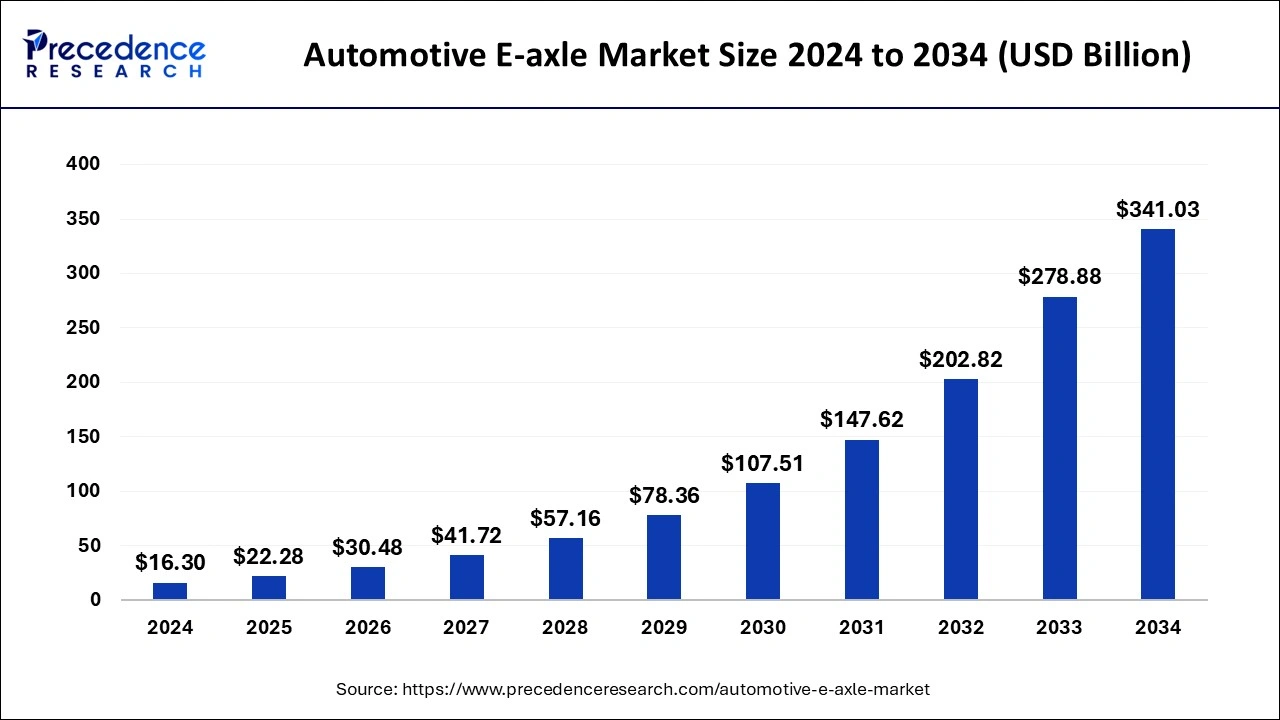
Market Highlights
- North America contributed more than 44% of market share in 2024.
- Asia-Pacific is estimated to expand the fastest CAGR between 2025 and 2034.
- By application, the rear segment has held the largest market share of 71% in 2024.
- By application, the front segment is anticipated to grow at a remarkable CAGR of 41.7% between 2025 and 2034.
- By electric vehicle type, the BEV segment generated over 63% of the market share in 2024.
- By electric vehicle type, the PHEV segment is expected to expand at the fastest CAGR over the projected period.
Automotive E-axle Market Overview: Shaping the Future
An automotive E-axle, short for electric axle, is a compact and integrated unit that combines the electric motor, power electronics, and gearbox within a single housing. This innovative technology is designed to propel electric vehicles efficiently and seamlessly. The E-axle replaces the traditional internal combustion engine and transmission, providing a more compact and simplified solution for electric propulsion. By consolidating essential components, the E-axle enhances the overall efficiency of electric vehicles, offering benefits such as reduced energy loss, improved power distribution, and simplified vehicle design. This streamlined approach contributes to the growing trend of electrification in the automotive industry, as manufacturers seek to create more sustainable and high-performance electric vehicles with the help of advanced technologies like the E-axle.
Automotive E-axle Market Data and Statistics
- AxleTech has created an integrated e-axle that achieves superior performance while maintaining a more compact design. Specifically designed for medium- and heavy-duty commercial trucks, this e-axle offers enhanced efficiency and power in a smaller package.
- European Union regulations mandate a fleet-wide average emission target of 95 grams of CO2 per kilometer for new cars, contributing to the push for electric vehicle adoption.
- As of 2022, EV sales have been steadily increasing, with over 3.1 million electric cars sold worldwide in 2021, marking a significant surge compared to previous years.
Automotive E-axle MarketGrowth Factors
- The increasing global shift towards electric vehicles is a key driver for the automotive E-axle market. With a growing emphasis on sustainability and reduced dependence on traditional internal combustion engines, automakers are integrating E-axle technology to power electric vehicles.
- Stringent emissions regulations imposed by governments worldwide are pushing automakers to adopt electric powertrains, including E-axles. Compliance with emission standards, such as those set by the European Union and other regions, is a driving force behind the market's growth.
- Continuous improvements in battery technology are enhancing the efficiency and range of electric vehicles equipped with E-axles. Innovations in battery chemistry, energy density, and charging infrastructure are contributing to the overall growth of the E-axle market.
- The decreasing costs associated with electric vehicle ownership, including maintenance and fuel expenses, are making electric vehicles more attractive to consumers and commercial fleet operators. E-axles play a crucial role in achieving higher efficiency and lower maintenance costs, contributing to the overall reduction in the total cost of ownership.
- Growing investments in electric mobility and infrastructure development are bolstering the E-axle market. Governments, as well as private sector players, are investing in charging infrastructure, research and development, and manufacturing capabilities for electric vehicles, fostering a conducive environment for E-axle adoption.
- Ongoing technological advancements, including innovations in electric motor design and power electronics, are driving the growth of the E-axle market. Additionally, strategic collaborations between automotive manufacturers and technology providers are facilitating the development of integrated and high-performance E-axle solutions.
Automotive E-axle Market Outlook: The Road Ahead
- Industry Growth Overview: The growth in the electric vehicle adoption, technological advancements, and stringent government emission regulations is driving the industrial growth in the market.
- Major Investors: Large and established tier 1 automotive suppliers, such as NIDEX Corporation, Dana Incorporated, and Magna International Inc., are the major investors in the market.
- Startup Ecosystem: The startup ecosystem is focusing on innovating and providing highly efficient, integrated, specialized, and affordable propulsion systems.
Market Scope
| Report Coverage | Details |
| Global Market Size in 2025 | USD 22.28 Billion |
| Global Market Size in 2026 | USD 30.48 Billion |
| Global Market Size by 2034 | USD 341.03 Billion |
| Base Year | 2024 |
| Forecast Period | 2025 to 2034 |
| Segments Covered | Application and Electric Vehicle Type and Region |
| Regions Covered | North America, Europe, Asia-Pacific, Latin America, and Middle East & Africa |
Market Dynamics
Drivers
Increasing electric vehicle adoption
- According to the International Energy Agency (IEA), the number of electric cars on the road surpassed 10 million in 2020.
The surge in electric vehicle (EV) adoption is a major catalyst propelling the demand for automotive E-axles. As more consumers and businesses transition towards environmentally friendly transportation, there's a growing need for efficient electric propulsion systems. E-axles play a pivotal role in this shift by integrating essential components like electric motors and power electronics into a compact unit. This consolidation enhances the overall performance of electric vehicles, making them more appealing to a broader audience.
The increased focus on sustainability and the recognition of EVs as a cleaner alternative to traditional vehicles drive the market demand for E-axles. Governments worldwide are also incentivizing the adoption of electric vehicles, further accelerating the demand for E-axle-equipped automobiles. As electric vehicles become increasingly mainstream and the automotive industry aligns with green initiatives, the E-axle market is experiencing a robust upswing, providing an essential solution for the evolving landscape of sustainable transportation.
Restraint
Battery technology challenges
Battery technology challenges pose significant restraints on the market demand for automotive E-axles. The limitations in current battery technologies, such as energy density, charging speed, and overall lifespan, directly impact the performance and feasibility of E-axle systems. The need for more powerful and efficient batteries is critical for maximizing the range and capabilities of electric vehicles (EVs) equipped with E-axles. Consumers are often concerned about the limited driving range of electric vehicles and the time it takes to recharge them.
As E-axles are closely tied to advancements in battery technology, addressing these challenges becomes pivotal to enhancing the appeal of EVs in the market. Manufacturers and researchers are actively working on improving battery technologies to overcome these limitations, but until these advancements are widespread, the automotive E-axle market may experience a slower adoption rate due to the perceived constraints related to battery performance.
Opportunity
Customization for various vehicle types
Customization for various vehicle types is a key factor creating significant opportunities in the automotive E-axle market. The adaptability of E-axle systems to different vehicle categories, such as passenger cars, commercial trucks, and buses, allows manufacturers to tailor solutions based on specific performance, size, and efficiency requirements. This versatility ensures that E-axles can meet the diverse needs of a broad range of customers in the automotive industry. As electric mobility gains traction across various vehicle segments, the ability to customize E-axle systems for different applications becomes a competitive advantage.
Manufacturers can cater to the unique demands of passenger vehicles seeking efficiency and performance, as well as the specific requirements of commercial fleets aiming for enhanced payload capacity and operational efficiency. This flexibility positions E-axle technology as a versatile solution, fostering growth and adoption across multiple sectors of the automotive market.
Segment Insights
Application Insights
The rear segment held the highest market share at 71% in 2024. In the automotive E-axle market, the rear segment refers to the integration of electric axle systems specifically designed for the rear wheels of a vehicle. This configuration is commonly employed to enhance traction, performance, and overall driving dynamics. A growing trend in this segment involves the adoption of rear E-axles in electric sports cars and high-performance vehicles. Manufacturers are leveraging rear E-axle setups to optimize power distribution, improve handling, and deliver a more dynamic driving experience in the evolving landscape of electric mobility.
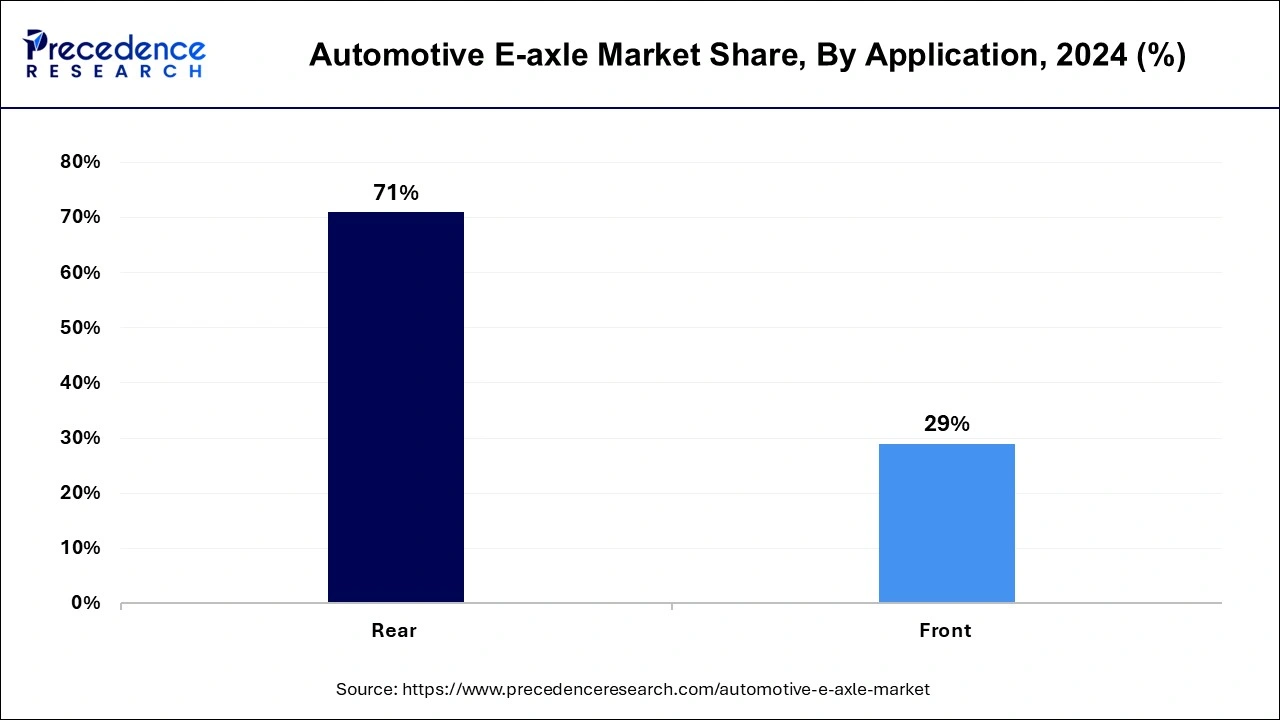
The front segment is anticipated to witness rapid growth at a significant CAGR of 41.7% during the projected period. In the automotive E-axle market, the front segment refers to the application of E-axle systems in the front axle of vehicles. This configuration is commonly found in electric and hybrid vehicles, where the electric motor of the E-axle is integrated into the front axle, contributing to improved traction and dynamic performance. Trends in the front E-axle segment include a growing preference for front-wheel-drive electric vehicles, as this setup often enhances stability and handling. Manufacturers are increasingly adopting front E-axles to optimize vehicle dynamics and overall driving experience.
Electric Vehicle Type Insights
The BEV segment has held 63% market share in 2024. In the automotive E-axle market, the Battery Electric Vehicle (BEV) segment specifically refers to electric vehicles powered solely by electric batteries without an internal combustion engine. In this segment, E-axles play a crucial role by integrating electric motors, power electronics, and gears into a compact unit, enhancing the performance and efficiency of BEVs. The trend in the BEV segment indicates a growing preference for E-axle technology due to its contribution to increased range, improved energy efficiency, and simplified design, driving the adoption of electric mobility.
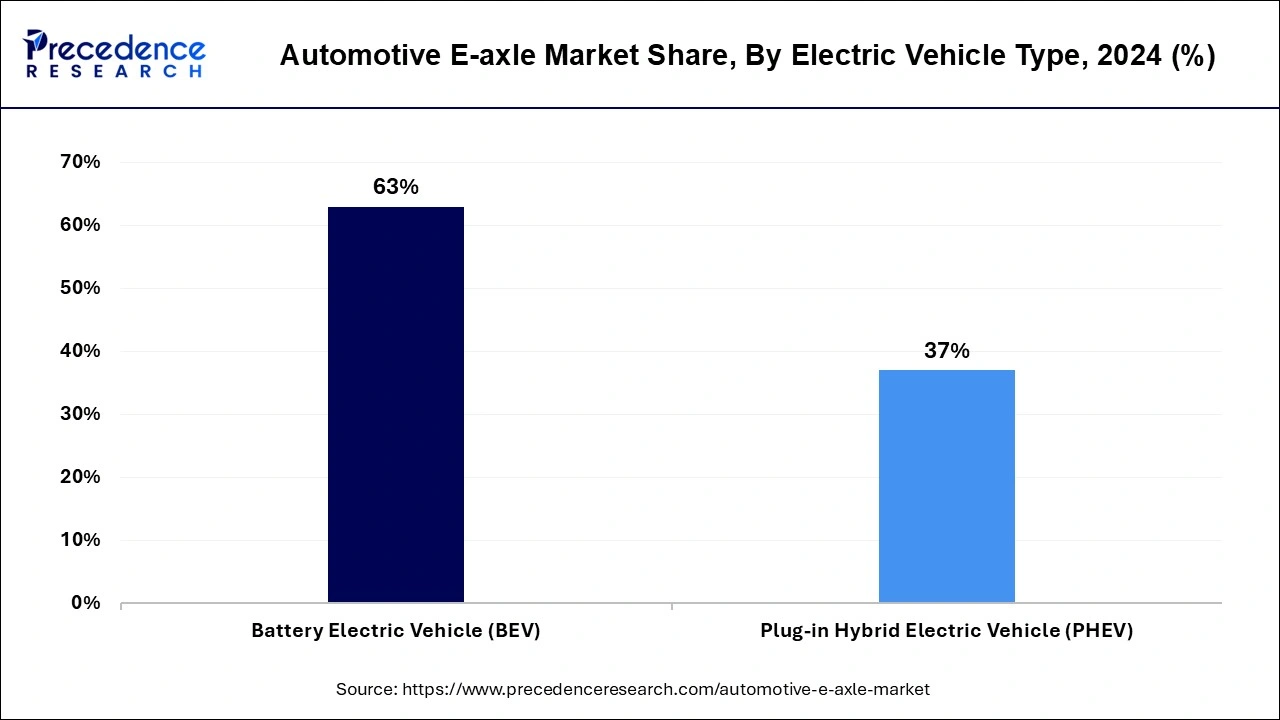
The PHEV segment is anticipated to witness rapid growth over the projected period. In the automotive E-axle market, the plug-in hybrid electric vehicle (PHEV) segment refers to vehicles that combine an internal combustion engine with an electric motor, allowing them to operate on both traditional fuel and electric power. The PHEV segment is witnessing a growing trend in E-axle adoption, as automakers aim to enhance the electric-only range of these vehicles. E-axles in PHEVs contribute to improved efficiency, reduced emissions, and greater flexibility for drivers who may switch between electric and conventional modes based on their needs and preferences.
Regional Insights
U.S.Automotive E-axle Market Size and Growth 2025 to 2034
The U.S. automotive E-axle market size is exhibited at USD 6.88 billion in 2025 and is projected to be worth around USD 106.65 billion by 2034, growing at a CAGR of 35.72% from 2025 to 2034.
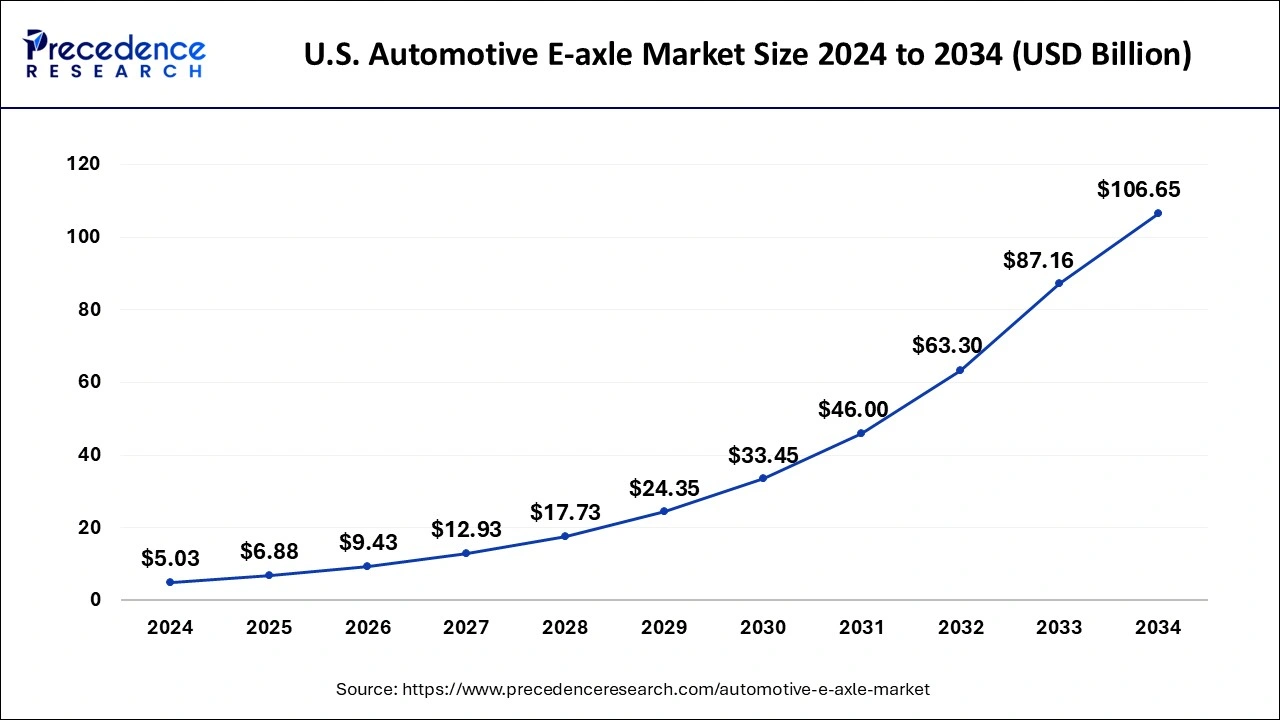
Investments Push U.S. Market
The growing investments in the electric e-axle are driving the demand for automotive e-axles in the U.S. Additionally, the growing adoption of electric vehicles, increasing innovations, and manufacturing are all increasing their capabilities, attracting consumers, where the government support is also encouraging their adoption.
Electric Vehicle Surge Powers North America
In 2024, North America held a share of 44% in the automotive E-axle market due to a combination of factors. The region exhibits a strong demand for electric vehicles, driven by environmental concerns and government incentives. Established automotive manufacturers in North America are actively investing in E-axle technology to meet the rising demand for electric and hybrid vehicles. Additionally, the presence of a well-developed charging infrastructure and a tech-savvy consumer base further propels the adoption of E-axles, contributing to North America's prominent position in the market.
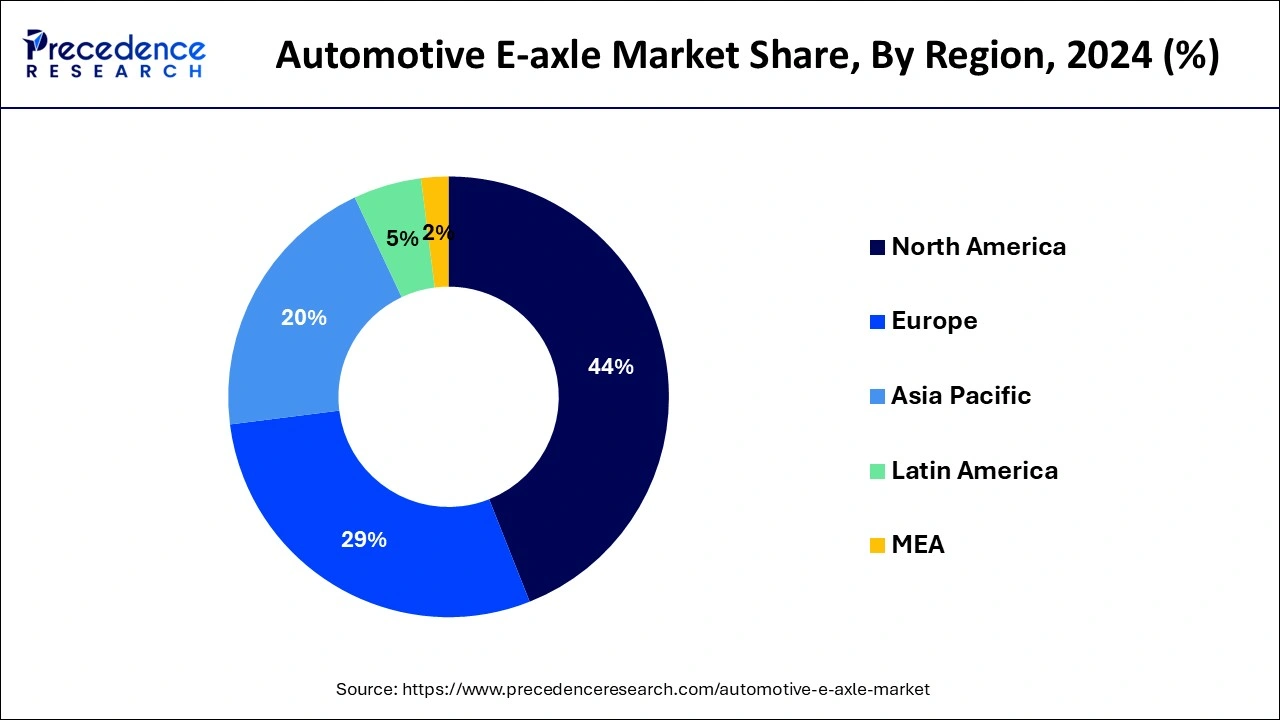
Government Initiatives Fuel the Asia Pacific
Asia-Pacific is positioned for rapid growth in the automotive E-axle market due to several factors. Governments in the region are actively promoting electric vehicle adoption through incentives and supportive policies. Additionally, the escalating demand for cleaner and sustainable transportation solutions aligns with the environmental goals of many Asian countries. The region's robust manufacturing capabilities and the increasing focus of automotive companies on developing electric vehicles contribute to the optimistic outlook for E-axle technology, making the Asia-Pacific market a key player in the global electric mobility landscape.
Sustainable Transportation Leads Europe
Meanwhile, Europe is experiencing notable growth in the automotive E-axle market due to several factors. The region's strong push for sustainable transportation, coupled with stringent emission regulations, has led to increased adoption of electric vehicles. Government incentives, robust charging infrastructure, and a heightened environmental awareness among consumers further drive the demand for E-axle technology. Additionally, collaborations between automakers and advancements in battery technology contribute to the growth, making Europe a key market for the development and adoption of E-axles in the automotive sector.
Electric Vehicle Adoption Powers India
Growing electric vehicle adoption is increasing the demand for e-axels in India as their critical component. The government initiatives are increasing their cost-effective manufacturing and R&D, where the growing environmental concerns are increasing their adoption rates for sustainable transportation.
Smart Cities Powers UK
The UK is experiencing an expansion in smart cities, which is increasing the use of electric vehicles and automotive e-axle technology. Moreover, the growing manufacturing ecosystems are increasing the advancements, which are leading to collaborations. Additionally, government initiatives are promoting their innovations.
Urbanization Boosts South America
South America is expected to grow significantly in the automotive e-axle market during the forecast period, due to increasing urbanization. The growing adoption of electric vehicles and government policies is increasing the demand for automotive e-axles. Additionally, the increasing investments, affordable manufacturing, and expanding sustainable transportation are promoting the market growth.
Argentina's E-Axle Ascent
Argentina's automotive E-axle market is in its infancy but poised for significant growth, driven by global sustainability trends and the rising adoption of electric vehicles. As local incentives and infrastructure improve, this market segment is expected to accelerate dramatically in the coming years.
Automotive E-axle Market Value Chain Analysis
- Raw Material Sourcing
Raw materials of automotive e-axle, like steel, aluminium alloys, copper, and rare earth elements, are sourced by the company.
Key players: Nippon Steel Corporation, Alcoa Corporation. - Testing and Quality Control
Performance, durability, noise vibrations and harshness (NVH), efficiency, and thermal management are evaluated in the testing and quality control of the automotive E-axle.
Key players: AVL, SGS, Intertek, Robert Bosch. - Retail Sales and Financing
The retail sales and financing of automotive e-axles involve their sales to vehicle manufacturers and large-scale long-term supply agreements, respectively.
Key players: ZF Friedrichshafen AG, Bosch Limited, Dana Incorporated.
The Market Transformers: Key Players' Offering
- ZF Friedrichshafen AG: The company provides products like electric axle drive and AxTrax.
- Dana Incorporated: The products like Spicer Electrified eS9000r, and eS4500r are provided by the company.
- Continental AG: An Integrated Axle Drive is provided by the company.
- Schaeffler AG: The company provides 2-in-1 electric axles.
- Bosch Limited: Bosch eAxle is provided by the company.
Recent Developments
- In June 2023, Idemitsu Kosan Co., Ltd. unveiled a pioneering solution named "E AXLE and Electric Parts Cooling Oil." This innovation, geared toward boosting performance in electric and hybrid vehicles, addresses drive units, electronics, and battery systems.
- Simultaneously, Musashi Auto Parts India Pvt. Ltd., a subsidiary of Musashi Seimitsu Industries, entered India's electric mobility market. Their plan involves manufacturing a comprehensive EV unit, including the motor, power control unit (PCU), and gearbox, beginning production at the Bengaluru plant in October 2023.
- In a collaborative effort, NIDEC CORPORATION and Renesas Electronics Corporation announced a partnership in June 2023 to develop semiconductor solutions for an advanced next-gen E-Axle system. This X-in-1 system aims to integrate an electric vehicle drive motor and power electronics, enhancing overall electric vehicle efficiency.
- In May 2023, Schaeffler India Limited, a subsidiary of Schaeffler Group, secured a significant Rs 2700 crore (Euro 300 million) order for their innovative two-in-one electric axles. This order reflects the company's strategic shift from internal combustion engines to electric powertrains.
Automotive E-axle Market Companies
- ZF Friedrichshafen AG
- Dana Incorporated
- Continental AG
- BorgWarner Inc.
- GKN Automotive Limited
- Schaeffler AG
- Siemens AG
- AAM (American Axle & Manufacturing)
- Magna International Inc.
- Bosch Limited
- AVL List GmbH
- NSK Ltd.
- Hitachi Automotive Systems
- Dana Limited
- JTEKT Corporation
Segments Covered in the Report
By Application
- Front
- Rear
By Electric Vehicle Type
- Battery Electric Vehicle (BEV)
- Plug-in Hybrid Electric Vehicle (PHEV)
By Region
- North America
- Europe
- Asia-Pacific
- Latin America
- Middle East and Africa
For inquiries regarding discounts, bulk purchases, or customization requests, please contact us at sales@precedenceresearch.com
Frequently Asked Questions
Ask For Sample
No cookie-cutter, only authentic analysis – take the 1st step to become a Precedence Research client



